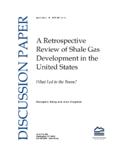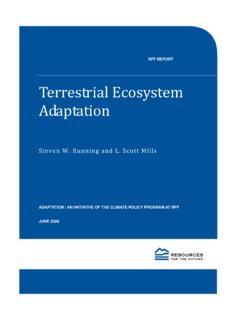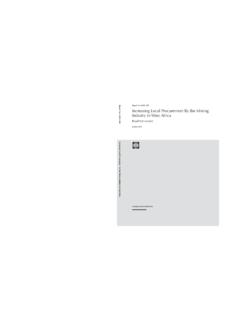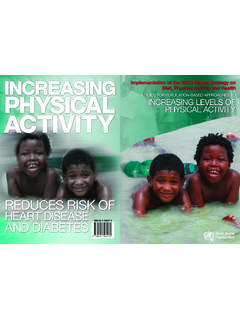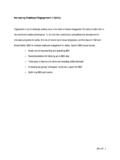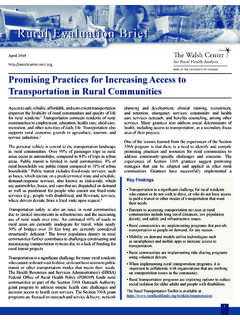Transcription of May 2009 RFF DP 09-21 DISCUSSION PAPER
1 1616 P St. NW Washington, DC 20036 202-328-5000 M a y 2009 R F F D P 09-21 Outdoor Recreation, Health, and Wellness Understanding and Enhancing the Relationship G e o f f r e y G o d b e y P r e p a r e d f o r t h e O u t d o o r R e s o u r c e s R e v i e w G r o u p R e s o u r c e s f o r t h e F u t u r e B a c k g r o u n d S t u d yDISCUSSION PAPER 2009 Resources for the Future. All rights reserved. No portion of this PAPER may be reproduced without permission of the authors. DISCUSSION papers are research materials circulated by their authors for purposes of information and DISCUSSION . They have not necessarily undergone formal peer review.
2 Outdoor Recreation, Health, and Wellness: Understanding and Enhancing the Relationship Geoffrey Godbey Abstract The research literature on outdoor recreation as it relates to human health is vast and growing. To help policymakers take new and emerging findings into account when designing recreation and park services and initiatives for the 21st century, this PAPER summarizes the salient issues and identifies research gaps. It considers how being outside in natural surroundings may improve health and how outdoor physical activities benefit participants. Particular attention is given to children s health problems that can be mitigated through outdoor play, sports, and nature study. The PAPER describes approaches to measuring physical activity and recent trends in park visitation and outdoor activity participation.
3 It looks at variables that affect participation in outdoor activities and considers the projected demographic changes that will affect policymaking in this arena. The findings of this literature review point to potential new directions for outdoor recreation policy, as well as new policy questions to be explored. Key Words: outdoor recreation, public health, physical activity, children s health JEL Classification Numbers: I18, Q26 Contents 1. Introduction .. 1 2. Health Benefits of Being Outdoors .. 2 General Health Benefits of Natural Spaces .. 3 Stress and the Environment .. 3 3. Health Benefits of Outdoor Recreation .. 5 General Health Benefits of Outdoor Activity .. 5 Stress and Outdoor Recreation.
4 6 Obesity and Outdoor Activity .. 7 4. Outdoor Recreation and Children s Health .. 7 Childhood Obesity .. 8 Attention Deficit Hyperactivity Disorder .. 8 Lack of Connection with Nature .. 9 Addressing Children s Wellness Issues .. 10 5. Measures of Activity and Participation .. 12 Measures of Intensity .. 12 New Metrics .. 13 Trends in Participation .. 14 Use of Public Outdoor Spaces .. 15 6. Factors that Affect Participation .. 16 Leisure Time .. 17 Community Attributes .. 18 Proximity to Outdoor Spaces .. 19 Safety of Parks .. 20 Supply of Outdoor Spaces .. 21 Park and Playground Design and Features .. 21 Social Setting in Parks .. 22 Park Management and Policies .. 23 7. Looking Ahead .. 24 8. Policy Implications.
5 26 Managing Outdoor Recreation for Healthy Outcomes .. 26 Developing an Urban Strategy .. 26 Policy Options and Questions .. 27 References .. 29 Resources for the Future Godbey 1 Outdoor Recreation, Health, and Wellness: Understanding and Enhancing the Relationship Geoffrey Godbey 1. Introduction When the President s Commission on Americans Outdoors reviewed the nation s policies on outdoor recreation in 1985, the social, economic, and environmental benefits of recreation were recognized, but little attention was paid to human health benefits. Since then, however, research has confirmed a link between physical activity that takes place outdoors and positive health outcomes and also an association between an indoor, sedentary lifestyle and negative health consequences.
6 There is also evidence that both being outdoors and viewing natural scenes can reduce stress. The links are sufficiently strong that researchers and practitioners in health-related fields are now beginning to identify parks and recreation as a health service. Outdoor recreation s contribution to health can be considered in the context of wellness. The World Health Organization (2003) defines health as a state of complete physical, mental and social well-being and not merely the absence of disease or infirmity. This definition moves from a strictly medical model of health toward the concept of well-being. The Alberta Centre for Well Being (1989) finds that the concept of well-being or optimal health involves a delicate balance among physical, emotional, spiritual, intellectual and social health and then lists a wide range of dimensions, from fitness, nutrition, and stress management to meditation, education, and relationships.
7 Outdoor recreation touches on all those aspects of health and can enhance not only physical health but also emotional well-being. Just being outdoors, for example, has been shown to confer health benefits. The research literature on outdoor recreation as it relates to human health is vast and growing. To help policymakers take these new and emerging findings into account when designing recreation and park services and initiatives for the 21st century, this PAPER summarizes Professor Emeritus, Department of Recreation, Park and Tourism Management, Pennsylvania State University. The author acknowledges the help of Dr. B. L. Driver, Dr. Andrew Mowen and Dr.
8 Laura Payne in the development of this PAPER . Resources for the Future Godbey 2 the salient issues. Throughout, the reader will find questions that identify research gaps an indication that the subject area is fertile ground for additional attention. Section 2 considers how being outside in natural surroundings may improve health, and Section 3, how outdoor physical activities benefit participants. Section 4 examines children s health problems obesity and hyperactivity in particular that can be mitigated through outdoor play, sports, and nature study. Section 5 describes approaches to measuring physical activity and recent trends in park visitation and outdoor activity participation, and Section 6 looks at the many variables that affect people s participation in outdoor activities.
9 Section 7 considers the projected demographic changes that will affect policymaking in this arena. The concluding section brainstorms policy options. 2. Health Benefits of Being Outdoors Living in comparatively natural areas, viewing nature, and having outdoor recreation areas and facilities nearby appear to provide health benefits: ..the major determinants of health may have little to do with the health-care system (Hancock 1999) and public health needs to focus on the environmental and social aspects of health (Chu and Simpson 1994). Publicly owned natural spaces are an ideal resource to support these and other aspects of human health and well-being. (Maller et al. 2005, 5) That assertion is based on anthropological understanding.
10 Humans evolved for a life spent in small groups, hunting and gathering on the plains of Africa. Natural selection has not had time to revise our bodies for coping with fatty diets, automobiles, artificial light, and central heating. This mismatch between our design and today s environment may account for many preventable modern diseases (Nesse and Williams 1996). Even the landscapes we find preferable may reflect our origins. Of all the possible landscapes, the African savanna grassy plains punctuated by spreading, mature trees, usually with water present is the most popular: So well do we love the savanna that we have recreated it all over the globe in the wide tree canopies and lack of undergrowth found in the Japanese Zen garden, the English landscape, and the American city park (Knize 1998, 132).



